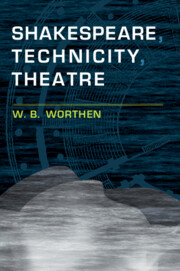Book contents
- Shakespeare, Technicity, Theatre
- Shakespeare, Technicity, Theatre
- Copyright page
- Contents
- Illustrations
- Acknowledgments
- Chapter 1 Introduction: Theatre, Medium, Technology
- Chapter 2 The Face, the Mask, the Screen: Acting and the Technologies of the Other
- Chapter 3 Shax the App
- Chapter 4 Interactive Remediation: Original Practices
- Chapter 5 Designing the Spectator
- Chapter 6 And Or And Not: Recoding Theatre
- Notes
- Works Cited
- Index
Chapter 3 - Shax the App
Published online by Cambridge University Press: 22 May 2020
- Shakespeare, Technicity, Theatre
- Shakespeare, Technicity, Theatre
- Copyright page
- Contents
- Illustrations
- Acknowledgments
- Chapter 1 Introduction: Theatre, Medium, Technology
- Chapter 2 The Face, the Mask, the Screen: Acting and the Technologies of the Other
- Chapter 3 Shax the App
- Chapter 4 Interactive Remediation: Original Practices
- Chapter 5 Designing the Spectator
- Chapter 6 And Or And Not: Recoding Theatre
- Notes
- Works Cited
- Index
Summary
Consider the postcard: a homely object, vestige of residual technologies, capturing a nexus of communications at the apogee of print culture, the moment of print’s transformation by photographic processes, the mid-nineteenth century.1 Postcards were patented in the United States in 1861, and the first penny postcards preprinted with postage by the US Post Office in 1873 depicted scenes from the Interstate Industrial Exposition. Postcards have, of course, taken a wide range of forms since, plain and illustrated, artistic, kitschy, pornographic. They’re used for advertising plays (both mailed and distributed by hand) and tourism. Inexpensive prepaid postcards facilitated popular communications in late-nineteenth-century India. They were printed with heroic illustrations for soldiers on all sides to send home during World Wars I and II.2 Postcards of British and American actors in Shakespearean roles circulated widely from the 1890s through World War I.3
- Type
- Chapter
- Information
- Shakespeare, Technicity, Theatre , pp. 68 - 103Publisher: Cambridge University PressPrint publication year: 2020

